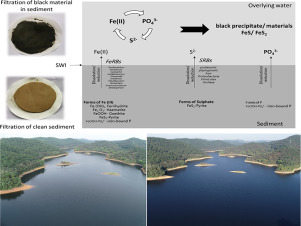当前位置:
X-MOL 学术
›
Sci. Total Environ.
›
论文详情
Our official English website, www.x-mol.net, welcomes your feedback! (Note: you will need to create a separate account there.)
High resolution evidence of iron-phosphorus-sulfur mobility at hypoxic sediment water interface: An insight to phosphorus remobilization using DGT-induced fluxes in sediments model.
Science of the Total Environment ( IF 9.8 ) Pub Date : 2020-03-28 , DOI: 10.1016/j.scitotenv.2020.138204 Eyram Norgbey 1 , Yiping Li 2 , Zhu Ya 2 , Ronghui Li 3 , Amechi S Nwankwegu 2 , Georgina Esi Takyi-Annan 4 , Fan Luo 2 , Wei Jin 2 , Yanan Huang 2 , Linda Sarpong 2
Science of the Total Environment ( IF 9.8 ) Pub Date : 2020-03-28 , DOI: 10.1016/j.scitotenv.2020.138204 Eyram Norgbey 1 , Yiping Li 2 , Zhu Ya 2 , Ronghui Li 3 , Amechi S Nwankwegu 2 , Georgina Esi Takyi-Annan 4 , Fan Luo 2 , Wei Jin 2 , Yanan Huang 2 , Linda Sarpong 2
Affiliation

|
The deterioration of reservoirs in southern China due to the kinetics of Iron (Fe), Phosphorus (P) and sulphide (S) at the sediment-water interface (SWI) is a major problem that needs urgent attention. Studies on the biogeochemistry of Fe, P, and S using high-resolution profile techniques in reservoirs in this region are limited. The diffusive gradient in thin films (DGT) technique, high-resolution dialysis, DGT-computer imaging densitometry (CID), DGT-induced fluxes in sediments (DIFS) and planar optode (PO) device were used to describe the dynamics Fe-P-S in SWI during hypoxia. The results showed the release of Fe-P-S in SWI was due to sulfate reduction and iron reduction influenced greatly by hypoxia. Positive apparent fluxes were recorded indicating that the sediments release Fe-P-S to the overlying water. High positive correlations (r2 > 0.7) for DGT-labile Fe and DGT-labile P in sediments revealed that iron-bound P controlled the release of P at SWI during reductive dissolution. The low correlation between DGT-labile Fe and DGT-labile S (r2 < 0.4) disclosed the combative nature between sulfate reduction and iron reduction process. The low correlation occurred because of the co-precipitation between Fe and S, forming black materials such as monosulfide (FeS) and pyrite (FeS2) in a hypoxic environment. The DIFS model showed the resupply ability (R-values) of P in sediments belonged to the partially sustained case with a steady state case of resupply at TB3 (Tc = 1088s, Kd = 1005.61 cm3/g R = 0.72, K-1 = 0.19 day-1) and TB4 (Tc = 712 s, Kd = 712.53 cm3/g, R = 0.78, K-1 = 0.46 day-1). The resupply rate belonged to the non-steady state case at TB1 (Tc = 10,990 s, Kd = 396.3 cm3/g, R = 0.35, K-1 = 0.07 day-1) and TB2 (Tc = 6097 s, Kd = 578.5 cm3/g, R = 0.45, K-1 = 0.10 day-1). The DGT-CID-PO-DIFS provided a deep insight on the mechanism of Fe-P-S and remobilization of P at SWI leading to Blackwater events and eutrophication.
更新日期:2020-03-28



























 京公网安备 11010802027423号
京公网安备 11010802027423号